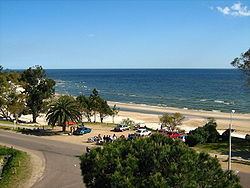Founded 1911 Postal code 16000 | Time zone UTC -3 Dial plan +598 437 (+5 digits) | |
 | ||
Atlántida is a resort town of the Costa de Oro in Canelones Department of Uruguay, 45 kilometres (28 mi) east of Montevideo.
Contents
- Map of Atlantida Canelones Department Uruguay
- Location
- History
- Population
- Beaches
- Landmarks
- Places of worship
- References
Map of Atlantida, Canelones Department, Uruguay
Atlántida is also the name of the municipality to which the town belongs and which includes a few more resort towns to the north and to the west of the town, i.e. Estación Atlántida, City Golf, Villa Argentina, Fortín de Santa Rosa and rural areas to their north.
Location
The resort is located on Ruta Interbalnearia, near the junction with Route 11.
History
Atlántida started in the beginning of the 20th century as a resort for the elite class of Montevideo and remained so until the mid-1950s. Today it is mainly a middle class resort with more than 4,600 permanent inhabitants.
The first plans of a resort in the area were drawn in 1911 and in the next year the parcelling and selling of plots began. In 1913 the Hotel Las Toscas was built near the beach, which in 1915 took on its actual name, Atlántida. The development accelerated from 1939 onwards, when Natalio Michelizzi (a wealthy Italian businessman living in Buenos Aires) decided to buy all the land that had not been parcelled or developed and invested in its development. On 7 September 1967 by the Act of Ley N° 13.609 it became classified as a city.
Population
According to the 2011 census, Atlántida had a population of 5,562. In 2010, the Intendencia de Canelones had recorded a population of 10,393 for the municipality during the elections.
Source: Instituto Nacional de Estadística de Uruguay
Beaches
The beaches of Atlántida are frequented by mainly by wealthy Uruguayans. They are characterized by being bordered by pine trees. the main beaches are Playa La Brava and Playa La Mansa. La Mansa is ideal for families, since the water is very calm, whilst La Brava typically has much rougher currents and is very popular with young people who enjoy water sports. These beaches are completely deserted in the winter months.
